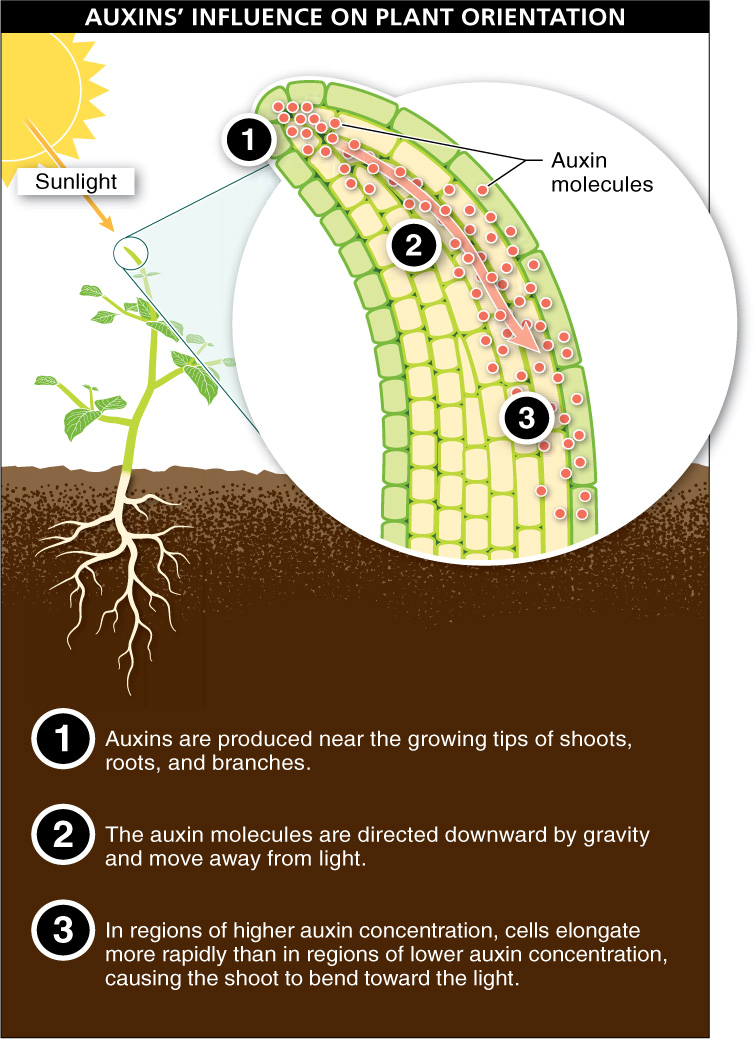19.6: Seedlings grow and properly orient themselves under the direction of auxins.


Auxins are a small group of naturally occurring hormones (and a larger group of synthetic variants that chemists can produce) that play several important roles in stimulating and regulating a plant’s growth and development. They are found primarily in shoot tips and immature plant tissue, such as young leaves. The primary role of auxins in plant growth is to stimulate the expression of genes that promote cell division, stem elongation, the formation of roots, and the formation of vascular cambium. Auxins also influence a plant’s orientation —its growth in response to directional light and gravity.
The chief effects of auxins are of four types (FIGURE 19-12).
1. Stimulating shoot elongation. Auxins enhance the effect of gibberellins in shoot elongation. As we saw in Section 18-
When the top meristem of a shoot is cut off, however, lateral buds that are lower on the plant increase their growth. The inhibition of the lateral buds by the apical meristem is called apical dominance and is caused by the large amount of auxin produced by the apical bud. Cutting off the top meristem removes the inhibiting source of auxin, which is why the lateral buds then grow. This is the basis for “pruning” and makes it possible to control the branching pattern and shape of plants.
2. Controlling seedling orientation. Charles Darwin and his son Francis were the first to document that seedlings exposed to light bend in whichever direction the light is coming from, whether up, down, or sideways. Immediately after emerging from the seed, the shoot grows as if it senses which way is up. Whether a shoot grows down into the earth or up toward the light, though, actually depends on (1) where the auxins are located and (2) how the auxins influence the cells in those specific locations. Like gibberellins, auxins are produced near the growing tips of shoots and branches, but unlike gibberellins, they don’t remain there. Auxin molecules move in two directions within a cell: they are pulled downward by gravity, and they move laterally away from light. These two movements distribute the auxin molecules unevenly within the plant. In regions of higher auxin concentration, cells in the stem elongate more rapidly than those in regions of lower auxin concentration (FIGURE 19-13). This difference in growth occurs because auxins increase the flexibility of the usually rigid cell wall (so that it can grow) and increase its permeability (so that it can take on more water and expand). The overall effect on growth is best seen when a plant is tipped onto its side. First, the auxins flow downward to the bottom side of the now-
774
3. Stimulating root branching. Auxins induce the formation of roots. In fact, you can buy auxin powders that can be dusted onto the bottom of plant stem cuttings. The powder causes the stems to send out numerous roots (transforming some stem cells into root cells), so that the cuttings can be planted and will form new plants.
775
4. Promoting fruit development. Auxins produced within an embryo have several roles in the development of fruit. First, they promote maturation of the ovary wall, and then they promote several steps in the full development of the fruit. It is even possible to trick plants into producing fruits by applying auxins to unfertilized flowers. Because there has been no fertilization, such fruits are always seedless (for example, seedless tomatoes). Auxins applied to fruiting plants can also prevent the fruits from prematurely dropping from the tree or vine. These fruits are easier and less expensive to harvest, because they can all be picked at one time.
Q
Question 19.3
How can we trick plants into producing seedless fruits for our convenience?
Too much of a good thing can be terrible, and this is particularly true when it comes to plant hormones. Auxins, for example, are among the chief growth-

The plant-
TAKE-HOME MESSAGE 19.6
Auxins are a small group of naturally occurring hormones found primarily in shoot tips and immature plant tissue (and a larger group of synthetic auxin variants) that play several important roles in stimulating and regulating a plant’s growth and development, often by increasing the usually rigid cell wall’s flexibility and permeability.
What are the four main physiological effects of auxins?